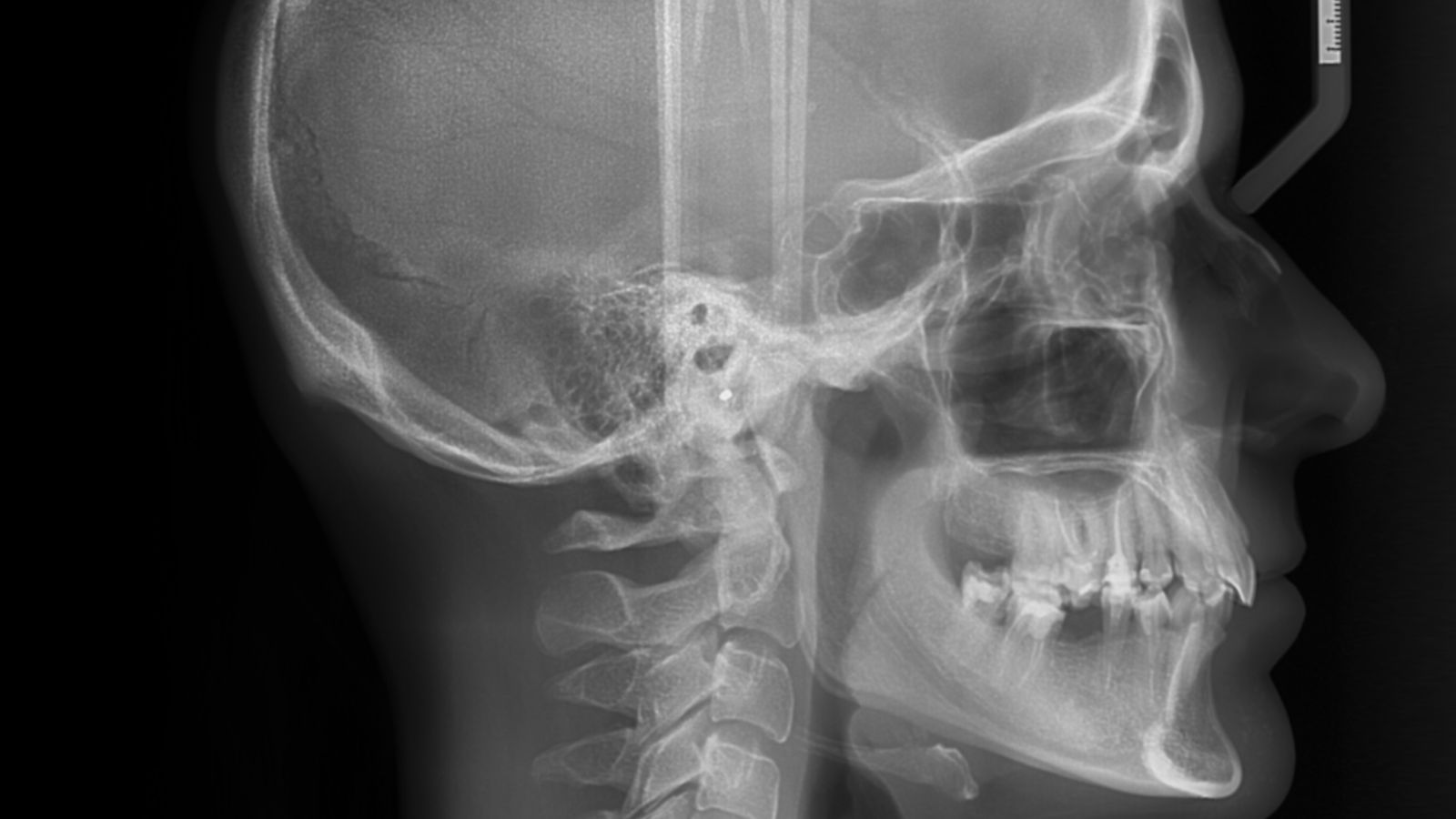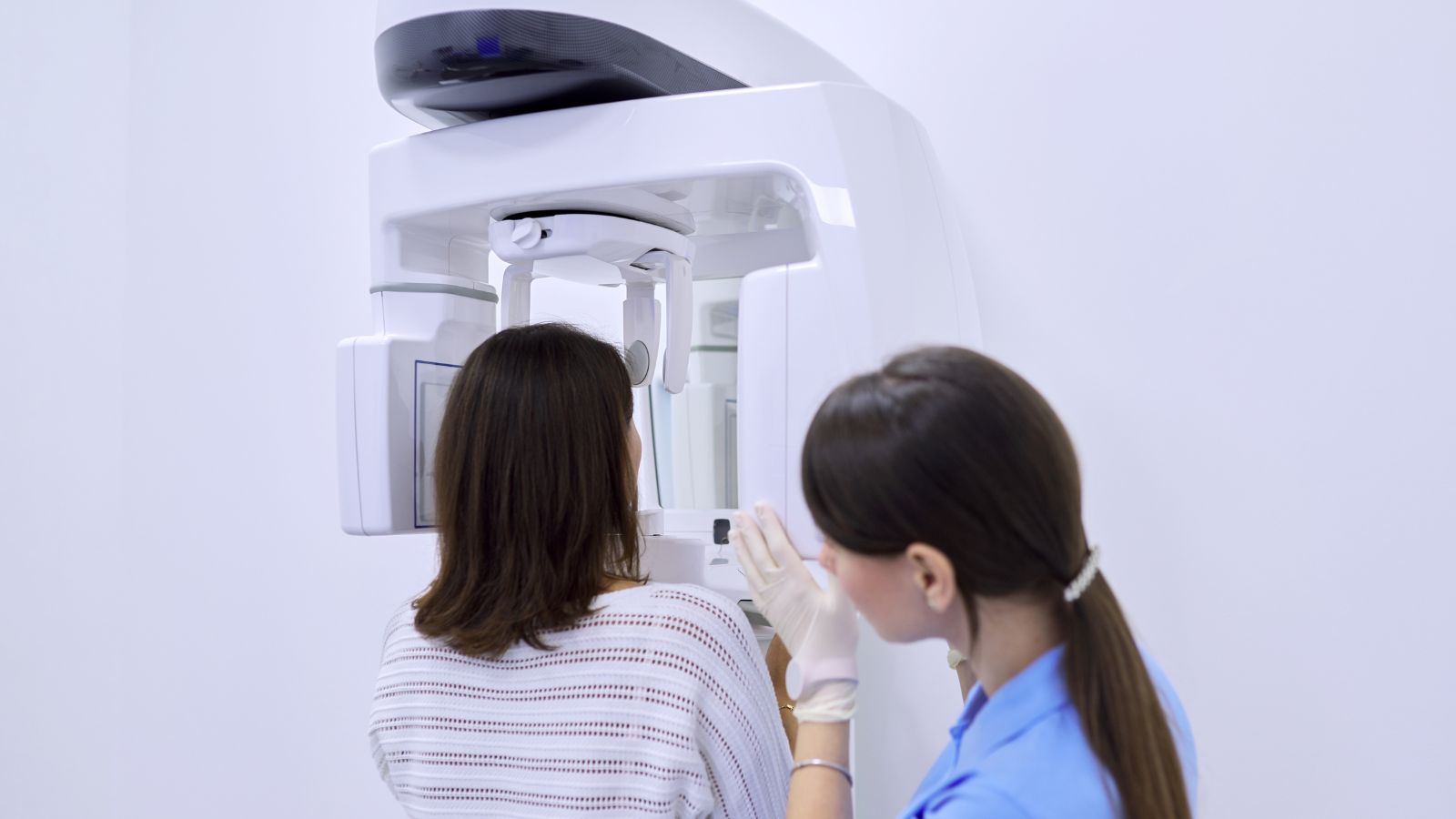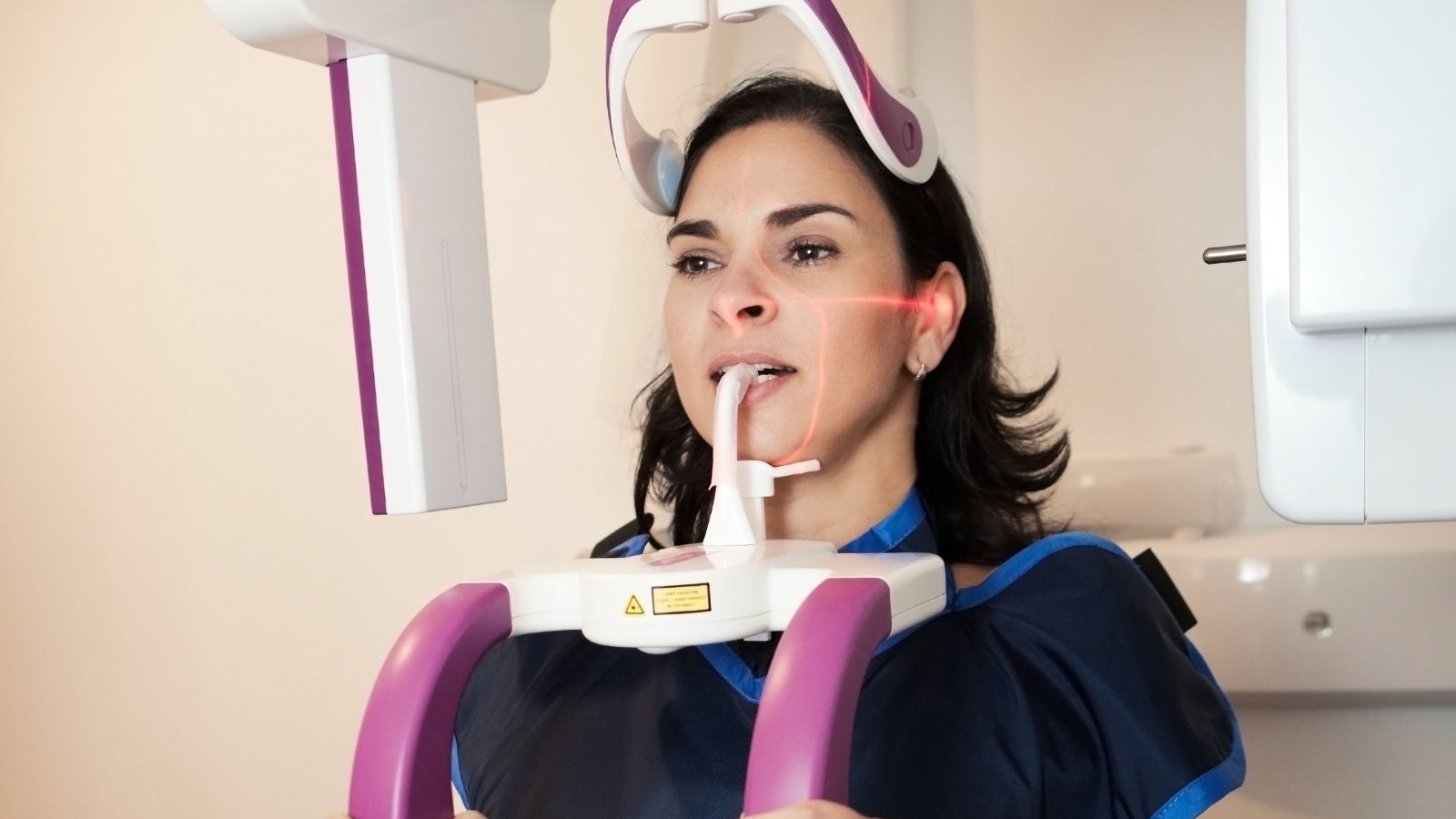Cephalometric X-rays are a crucial imaging method, particularly in orthodontics and dentistry specializing in the maxillofacial region. This method allows for a detailed examination of the relationships between the face, jaw, and cranial bones, identifying existing problems and providing guidance for planning future treatments. Essentially, these X-ray images, taken before, during, and after treatment, allow for close monitoring of changes in the structure of the teeth and jaw. In layman’s terms, Cephalometric X-rays allow for clear measurement and analysis of the position of the facial bones, the angles of the teeth, and the harmony of the jaws. This allows for the identification and analysis of the exact cause of misalignment, the determination of whether the jawbones are protruding or receding, and, if necessary, the planning of surgical procedures.
What is a Cephalometric X-ray and What is its Purpose?
A Cephalometric X-ray is a specialized X-ray image taken from the side (profile) or front of the head and face. Its primary purpose is to measurably examine the jaw-facial structure, tooth position, and profile view.
This X-ray technique serves as an invaluable guide in orthodontic treatment. Key points such as the position of the facial and jaw bones, the inclination of the teeth, and the condition of the jaw joint are visualized in a single image. These images help determine whether jaw relationships are within normal ranges, identify potential growth problems, and determine the appropriate orthodontic treatment methods. Monitoring changes during the growth spurt, especially in adolescent patients, is also facilitated by the use of a Cephalometric X-ray.
This X-ray also provides a significant advantage when planning jaw surgery. Issues such as the relative position of the jaws, the potential postoperative facial profile, and the new position of the teeth can be evaluated in detail during the preoperative preparation period. This increases the likelihood of achieving the desired aesthetic and functional results.
In Which Situations Are Cephalometric X-Rays Preferred?
Because Cephalometric X-Rays are used to investigate irregularities or growth disorders in the jaw-face region, they are frequently preferred in cases such as crowded teeth, skeletal problems, and when planning jaw surgery.
Dentists often request these images, especially for individuals considering orthodontic treatment. Cephalometric X-Rays become indispensable not only for irregular teeth but also for jawbones that are positioned too far back or too far forward, inconsistent upper and lower jaw relationships, overall facial length imbalances, or jaw asymmetry. Because the problem with orthodontic treatment may not be solely the teeth themselves. In some cases, skeletal problems such as a recessed or protruding jaw are the primary cause. Using these X-rays, the dentist can clarify whether the malocclusion is skeletal or dental in origin.
Follow-up X-rays are also occasionally requested for young patients whose growth has not yet completed. This allows them to determine the rate and direction of growth in the jaw. Whether the effect of orthodontic treatment or natural growth has altered the position of the teeth can also be monitored. For patients with more severe jaw problems, cephalometric X-rays are still a crucial part of surgical planning.
How Are Cephalometric X-rays Taken and What Equipment Is Used?
A cephalometric X-ray is taken with the patient’s head fixed in a specially designed device, and the patient’s head is viewed from the side or front during the scan.
A head immobilization device called a cephalostat is used for this scan. Two headphone-like supports are placed at the patient’s ears, and sometimes another support is used to stabilize the forehead. This keeps the head fixed relative to a specific reference plane. The distance between the X-ray tube and the digital sensor (or film) is determined and standardized for each patient. This ensures that the measurement results are comparable.
During the scan, the patient is upright, and the teeth are held in natural occlusion. In the lateral image, the rays pass through the full profile of the head and reach the sensor. In a frontal image, the rays are directed from the forehead toward the back. In both cases, the image reveals the measurable dimensions of the bones and teeth. Because digital sensors are mostly used today, the images are instantly displayed on a computer screen. This not only reduces radiation dose but also allows for immediate identification of any necessary repetitions.
Which Landmarks Does Cephalometric X-ray Help Detect?
A Cephalometric X-ray allows us to clearly identify strategic landmarks (landmarks) on the skull and face and determine their angular and spatial relationships.
These strategic landmarks are interconnected.The Sella (S), Nasion (N), A point (A), B point (B), Pogonion (Pog), Menton (Me), and Gonion (Go) are specifically named areas. For example, the Sella point is considered the center of the pituitary gland fossa at the base of the skull and is a reference point for many measurements. The Nasion point is the area where the forehead meets the nose. Point A represents the most concave part of the upper jaw, and point B represents the most concave part of the lower jaw.
The angles and distances calculated by determining these points clarify the relative position of the jawbones. Mathematically determining whether the upper jaw is forward or backward relative to the base of the skull, or whether the lower jaw’s position deviates from normal, helps make treatment planning much more targeted. Furthermore, the position of the teeth can be measured against different reference lines to determine whether they are excessively tilted forward (proclination) or backward (retroclination).
How Are Cephalometric X-ray Analyses Interpreted?
Cephalometric X-ray analyses are interpreted by comparing the resulting angle and distance values with average (normal) ranges and assigning them meaning based on the individual’s specific condition.
For example, the SNA angle indicates the position of the upper jaw relative to the skull base. The SNB indicates the position of the lower jaw relative to the skull base. The ratio of these two angles, the ANB, clarifies the difference in forward-backward position between the upper and lower jaws. A very high ANB generally suggests a skeletal Class II condition, where the upper jaw is positioned forward or the lower jaw is retracted. Conversely, a very low or negative ANB may indicate a Class III condition, where the lower jaw is positioned forward.
Regarding teeth, measurements such as the angle of the upper incisor to the skull base (U1–SN) or the angle of the lower incisor to the mandibular plane (IMPA) provide important clues. This determines whether the teeth are positioned in the correct axis—that is, whether they are positioned too far forward or too far back. During the interpretation process, it is important for the physician to consider the patient’s facial aesthetics and the individual structure of the teeth. Sometimes, deviations from average values can contribute positively to a person’s facial structure, and in this case, a holistic assessment is made, rather than a mere “normal value” approach.
What are the Advantages of Cephalometric X-rays?
Cephalometric X-rays offer numerous advantages in dentistry, particularly in orthodontics.
- First, because they are taken with a standardized positioning and fixed equipment distance, the results are highly comparable. Two different X-rays, taken at the beginning and end of treatment, allow for a clear visualization of actual growth or treatment-related changes. For example, the extent of advancement of the upper jaw or the change in the angle of the teeth can be numerically determined.
- Secondly, they are very effective in distinguishing skeletal and dental problems. This analysis makes it very easy to distinguish whether a person’s teeth are actually positioned too far forward due to a recessed jaw or simply because the teeth themselves are too forward. The treatment plan is then tailored accordingly.
- Thirdly, thanks to its low radiation dose, it can be safely used to monitor growth in children and adolescents. Cephalometric X-rays taken at regular intervals from the same patient provide the physician with concrete information about the direction, extent of growth, and its contribution to treatment.
- Finally, it also plays a critical role in patients considering orthognathic surgery. These X-ray analyses clarify issues such as pre-surgical planning, the expected post-operative facial profile change, and the effects of surgical interventions on the tissue.
What Are the Limitations and Disadvantages of Cephalometric X-rays?
While cephalometric X-rays offer numerous benefits, they also have some limitations and disadvantages.
The most prominent limitation is that the resulting image is two-dimensional. Because the face and jaw bones have a three-dimensional structure, some information overlaps in a single image taken from the side or front. For example, in a side view, the right and left jaws appear overlapping, and asymmetries are not fully revealed. This sometimes complicates analysis.
Another disadvantage is that identifying some bone or soft tissue landmarks is based on observation. If landmarks are not accurately identified, the margin of error in measurements increases. Therefore, analysis by an experienced person yields more accurate results. While computer-aided or artificial intelligence-based automatic recognition systems are becoming more widespread, confirmation by an expert is still required.
Furthermore, a single cephalometric X-ray does not reveal every problem. For example, detailed structures in the jaw joint (TMJ) or problems such as cysts on the roots of teeth should be examined using different angles or three-dimensional imaging methods. In some complex cases, a single x-ray may not provide all the information the physician needs.
Why Is Combining Cephalometric X-rays with Digital Methods Important?
Combining Cephalometric X-rays with digital methods allows for the measurement of the bone and soft tissue.This allows for faster and more precise imaging, providing significant convenience for both the patient and the physician.
Digital sensors enable the same quality image to be obtained with a lower dose of radiation compared to traditional film-based X-rays. Furthermore, the results appear instantly on the screen. This allows the patient’s positioning to be corrected if any errors or undesirable movements are detected during the scan. Furthermore, digital analyses can be supported by automation. This means that artificial intelligence-based algorithms are used to identify specific points, providing faster results than human-based methods.
Digitalization also allows the physician to upload these images to the analysis program, move the teeth and jaw virtually, and simulate potential treatment outcomes in advance. This provides a significant advantage, particularly in surgical planning and the digital design of orthodontic braces. For example, it becomes easier to predict how far the upper jaw should be moved, how the facial profile will appear, or which area of the tooth extraction will achieve the desired result. All of this contributes to a clearer understanding of the patient’s treatment process and strengthens patient-physician communication.
How is Radiation Safety Ensuring in Cephalometric X-rays?
Although the radiation dose in cephalometric X-rays is generally very low, safety precautions are still taken to prevent unnecessary exposure.
To ensure this protection, the ALARA (Lowest Reasonable Dose) principle applies. This means that an X-ray should be performed only when absolutely necessary and with the lowest possible dose. Collimation, a technique called collimation, limits the X-ray beam to the relevant area of the head. This prevents unnecessary radiation exposure to other parts of the body.
The patient usually wears a lead apron. While a thyroid shield is sometimes recommended, the projection area of a cephalometric X-ray usually does not directly affect the thyroid area. However, if necessary and to avoid compromising the quality of the X-ray, additional protective measures may be considered. During this process, personnel perform the scans behind protective barriers such as control panels or lead walls. Keeping the dose low with digital devices and preventing unnecessary re-examinations is also a priority in modern clinics. This ensures maximum safety for both the patient and healthcare professionals.
What Innovations Are Expected in the Future of Cephalometric X-rays?
The future of cephalometric X-rays is expected to see the further expansion of three-dimensional imaging technologies and the development of artificial intelligence-supported automated analyses.
Cone Beam Computed Tomography (CBCT), a three-dimensional imaging method, can present cross-sectional views of the head, jaw, and teeth, allowing for clear visualization of any asymmetries. While this technology is becoming increasingly widespread, radiation dose and cost are currently still considered obstacles. However, lower-dose protocols are being developed for newer-generation devices.
Furthermore, AI-based programs aim to mark specific bone or soft tissue points on cephalometric X-rays without requiring human intervention. Significant advances are being made in reducing the margin of error and accelerating analysis. This could enable more accurate results in orthodontic treatment or jaw surgery planning in a shorter time.
Using digitally generated information, 3D printing technologies make it possible to produce personalized surgical guides or orthodontic appliances. All of these innovations can be considered complementary or transformative to cephalometric radiography. While cephalometric radiography remains the most frequently used and fundamental method, 3D data, digital analysis, and personalized treatment planning may become even more widespread in the future, potentially partially replacing or significantly supplementing this technique.


